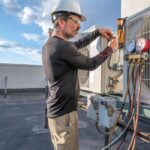Furnace short cycling is a common issue many homeowners face, especially during the colder months when the heating system is under constant use. Short cycling occurs when the furnace turns on and off too frequently, never completing a full heating cycle. Not only can this lead to discomfort, but it also places unnecessary strain on your furnace, potentially shortening its lifespan. Let’s discuss why your short cycling furnace might be acting up, what causes this issue, and, most importantly, how you can fix it.
Understanding Short Cycling: What is a Short Cycling Furnace?
When a furnace short cycles, it starts and stops repeatedly within short intervals without reaching the desired temperature set on the thermostat. This behavior can be triggered by several issues, which we’ll explore in detail. Knowing the difference between normal cycling and short cycle furnace activity is essential, as short cycling can significantly impact both your comfort and energy bills. So, why does it happen?
Why is My Furnace Short Cycling?
The reasons for furnace short cycling vary, but it’s typically due to one or more underlying issues within the furnace or the home. Below are some common furnace short cycling causes and what to watch out for.
What causes a furnace to short cycle?
Several factors can lead to a furnace’s short cycle. Understanding these causes will help you identify potential fixes to restore your furnace’s normal operation.
1. Dirty Air Filters
One of the most frequent furnace short-cycling causes is a dirty or clogged air filter. When the air filter becomes clogged with dust, dirt, and debris, it restricts airflow to the furnace. This lack of airflow causes the furnace to overheat, which triggers a safety shutoff. The furnace then attempts to turn on again, only to shut off once more due to overheating. Replacing or cleaning the air filter regularly can help avoid this short cycling issue.
2. Thermostat Issues
Another reason for a short cycling furnace could be an improperly functioning thermostat. If your thermostat is located in a drafty area or too close to a heat source, it may give inaccurate temperature readings, causing the furnace to turn on and off unnecessarily. In some cases, the thermostat might simply be malfunctioning. Replacing the thermostat or adjusting its location can often resolve short cycling.
3. Oversized Furnace
An oversized furnace can also cause furnace short cycling. When a furnace is too powerful for the space it’s intended to heat, it may warm up the area too quickly and shut off before completing a full cycle. This leads to a cycle of rapid starts and stops. In such cases, replacing the furnace with a correctly sized unit may be the most effective long-term solution.
4. Blocked or Closed Vents
If vents are blocked or closed, the furnace may struggle to distribute heat evenly throughout your home. This can result in uneven heating and trigger the furnace to turn on and off more frequently. Checking and opening all vents in your home can often help eliminate furnace short cycling caused by poor airflow.
5. Faulty Flame Sensor
The flame sensor is a crucial component that detects whether the gas burners are ignited. If the sensor becomes dirty or malfunctions, it may shut the furnace off prematurely. Cleaning or replacing the flame sensor can be a straightforward solution to prevent a short-cycling furnace.
Is Furnace Short Cycling Dangerous?
A furnace is short cycling when it operates inefficiently, which can be risky in certain cases. Short cycling often leads to increased wear and tear, causing components to fail sooner. If left unchecked, short cycling may eventually lead to a complete system breakdown, which could be costly and inconvenient during colder months.
In addition to mechanical strain, short cycling can lead to high energy bills. Because the furnace continuously turns on and off, it consumes more fuel than necessary, raising both your energy costs and carbon footprint. If you notice that your furnace is short cycling, it’s best to address the issue as soon as possible to avoid further complications.
How to Fix a Short Cycling Furnace
Once you understand the potential causes of short cycling, you can take steps to address the issue. Here are some troubleshooting tips for fixing a short cycling furnace.
1. Replace or Clean the Air Filter
As noted, a clogged air filter is one of the most common furnace short cycling causes. Replace or clean your air filter at least every three months, or more frequently if you have pets or live in an area with high dust levels. This simple step can improve airflow, reduce strain on the furnace, and resolve short cycling issues.
2. Inspect and Reposition the Thermostat
If you suspect your thermostat is causing your furnace to short cycle, check its placement and functionality. Thermostats should ideally be located in a central area away from drafts, direct sunlight, or other heat sources. If needed, replace the thermostat or consult an HVAC technician to reposition it.
3. Open Vents and Unblock Airflow
Ensure that all vents and registers in your home are open and free from obstructions. Blocked vents restrict airflow, forcing your furnace to work harder and potentially leading to short cycling. By allowing for unobstructed airflow, you can improve the furnace efficiency of your furnace and prevent overheating.
4. Clean or Replace the Flame Sensor
A dirty or faulty flame sensor can lead to a furnace short cycle. Turn off the furnace, locate the flame sensor, and gently clean it with fine sandpaper or a cloth. If cleaning doesn’t resolve the issue, it may be time to replace the sensor. Consult your furnace’s manual for instructions or contact a professional HVAC technician.
5. Consider Furnace Replacement for Oversized Units
If your furnace is oversized for your home, short cycling may be unavoidable without a replacement. Oversized units often fail to complete a full heating cycle because they heat the area too quickly. Consider having a heating professional evaluate your system and recommend a properly sized furnace if replacement is necessary.
Preventing Furnace Short Cycling in the Future
Addressing the root cause of furnace short cycling is important, but so is preventing it from happening again. Here are a few preventive tips:
- Regular Maintenance: Schedule routine maintenance with an HVAC technician to keep your furnace in top condition.
- Monitor Air Quality: Replace or clean air filters regularly to maintain airflow and reduce the risk of overheating.
- Check Thermostat Settings: Ensure your thermostat is set to an appropriate temperature and located in a central, neutral area.
Read to know more: winter furnace maintenance
Conclusion: Get Your Furnace Back to Normal
A short cycling furnace can disrupt your comfort and increase your energy costs, but by understanding the causes and solutions, you can get your heating system back to its best performance. Whether it’s a clogged filter, thermostat issue, or an oversized unit, identifying and addressing the cause of furnace short cycling can help you maintain a comfortable and energy-efficient home.
If you’re uncertain about fixing a furnace short cycle problem yourself, reach out to a professional HVAC service who can assess and resolve the issue. By taking preventive measures and staying on top of maintenance, you can keep your furnace running smoothly and enjoy a warm, comfortable home all winter long.







